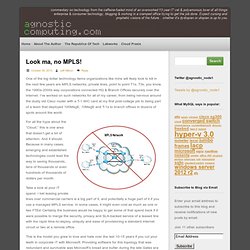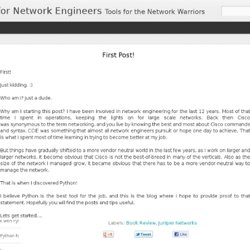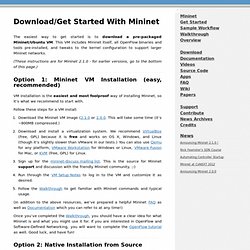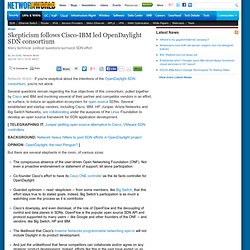

Software-Defined Networking » Plvision. Agnostic Computing. One of the big dollar technology items organizations like mine will likely look to kill in the next few years are MPLS networks, private lines, point to point T1s, T3s, you know, the 1990s-2000s way corporations connected HQ & Branch Offices securely over the internet.

I’ve worked on such networks for all of my career, from being nervous around the dusty old Cisco router with a T-1 WIC card at my first post-college job to being part of a team that deployed 100MegE, 10MegE and T-1s to branch offices in dozens of spots around the world. For all the hype about the “Cloud,” this is one area that doesn’t get a lot of attention.
And it should. Because in many cases, emerging and established technologies could lead the way to saving thousands, tens of thousands or even hundreds of thousands of dollars per month. Take a look at your IT spend. This is the model you grew to love and hate over the last 10-15 years if you cut your teeth in corporate IT with Microsoft. IT Analysts Blogs - ESG Research - Enterprise Strategy Group. SDN jobs: Skills network engineers should focus on. Software-defined networking (SDN) is evolving at a blistering pace now and raising many questions about the new skills networking pros will need for SDN jobs and how they can acquire them.

One of the biggest challenges associated with SDN is change. Changing networks mean introducing new ideas and, ultimately, risks as well. Enterprises increasingly demand zero downtime from their networks. How can you introduce these disruptive technologies without disrupting your network? Network pros who understand SDN will play a critical role. Will there be a need for 'SDN engineers,' and what will they do? When asking this question, you’ll be met with: "How do you define SDN? " Because SDN is used to label so many different implementations of technology, it's difficult to define SDN jobs specifically, according to Eric Hanselman, research director of 451 Research's networking practice. "Is there a virtualization engineer yet?
It's possible that SDN jobs will never stand as a separate category. Python for Network Engineers. Taking a break from all the SDN/POX/OpenFlow from the last few weeks, I have the pleasure of reviewing Juniper Networks Warriors today.

Title: Juniper Networks Warror Publisher: O'Reilly Media Product Details: I really like this book. I have held a number of different posts in networking, and can related to the analogy of a 'Network Warrior'. Heck, the title even rhymes with my blog title, right? This is a no-none-sense, practical-approach, real-world-example kind of a book. The bottom line is that if you are deploying a project similar to any of the examples, especially using Juniper gears, this book is probably worth its weight in gold for you.
I would highly recommend this book to any inspired 'network warriors'. Download/Get Started with Mininet - Mininet. The easiest way to get started is to download a pre-packaged Mininet/Ubuntu VM.

This VM includes Mininet itself, all OpenFlow binaries and tools pre-installed, and tweaks to the kernel configuration to support larger Mininet networks. (These instructions are for Mininet 2.1.0 - for earlier versions, go to the bottom of this page.) Option 1: Mininet VM Installation (easy, recommended) VM installation is the easiest and most foolproof way of installing Mininet, so it’s what we recommend to start with.
Follow these steps for a VM install: Download the Mininet VM image (2.1.0 or 2.0.0. (In addition to the above resources, we’ve prepared a helpful Mininet FAQ as well as Documentation which you can refer to at any time!) Once you’ve completed the Walkthrough, you should have a clear idea for what Mininet is and what you might use it for. Option 2: Native Installation from Source This option works well for local VM, remote EC2, and native installation. Git clone. Skepticism follows Cisco-IBM led OpenDaylight SDN consortium. If you're skeptical about the intentions of the OpenDaylight SDN consortium, you're not alone.

Several questions remain regarding the true objectives of this consortium, pulled together by Cisco and IBM and involving several of their partner and competitor vendors in an effort, on surface, to induce an application ecosystem for open source SDNs. Several established and startup vendors, including Cisco, IBM, HP, Juniper, Arista Networks and Big Switch Networks, are collaborating under the auspices of the Linux Foundation to develop an open source framework for SDN application development. [ TELEGRAPHING IT: Juniper plotting open source alternative to Cisco, VMware SDN controllers To continue reading, register here to become an Insider It's FREE to join Network World - If you're skeptical about the intentions of the OpenDaylight SDN consortium, you're not alone.
BACKGROUND: Network heavy hitters to pool SDN efforts in OpenDaylight project OPINION: OpenDaylight: the next Penguin? SDN jobs: Skills network engineers should focus on. April 2012.